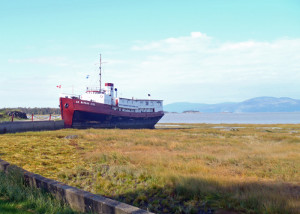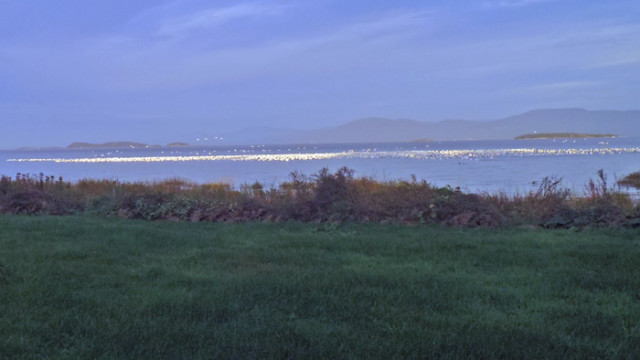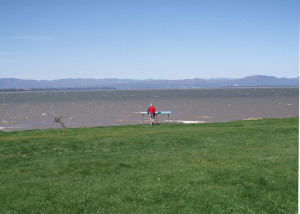
Even if you haven’t been there, you’ve at least heard of Québec City, right? Vibrantly modern, rich in history, with wonderful hotels and auberges, amazing food, and unlimited cultural opportunities, it’s truly one of the great cities of North America. It’s like visiting a European city without getting on an airplane. If you like cities at all, Québec City has to be on your must-visit list.
Much to my wife’s chagrin, however, I’m most definitely not a city person. But even I enjoy staying in, eating in, and, most of all, walking in Québec City. I’m good for one night and at least part of one day. Then, I’m ready to get out and go exploring in quieter places.
If you too are looking for someplace a little quieter to explore, but still near Québec City, consider the Chaudière-Appalaches region of Québec. This region hides west and north of the Maine border and doesn’t get much publicity. In fact it is probably rarely noticed by the American tourists passing through here on their way to Québec City. That’s a shame, because there’s a lot here.
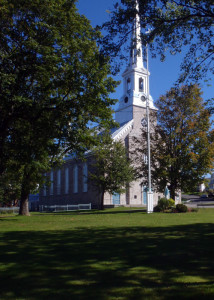
In September, Marilyn and I spent three days poking along the south shore of the St. Lawrence River, traveling by car when we had to, by foot, ferry boat and bicycle when we could, savoring windswept vistas complete with countless thousands of snow geese and other waterbirds, beautiful farms and forests with leaves turning to autumn colors, historic churches, modern hotels, elegant manoirs, inns and intimate auberges. On the way, we met some wonderful people, ate some incredible food (as you always do in Québec ). . . and, incidentally, traveled through time. We were a little too early in a warm fall, but what a perfect spot to go leaf-peeping before the foliage season in New England gets started!
Our original plan had been to park our car at the shiny new Four Points Sheraton in Lévis, a bustling suburb on the south shore of the St. Lawrence River with a spectacular view of Québec City across the river. From there, we planned to pedal east along Route 132, following the river out to Montmagny, about 35 miles away, then pedal back a couple of days later. Our plans changed when we faced an unrelenting 50 to 60 mile-per-hour northeast gale which would be blowing directly in our faces all the way out to Montmagny. Winds this high make even walking difficult, and can be dangerous on a bike, even one as big and stable as our tandem tourer. So we kept the bike on the roof rack and drove our planned route. Normally, I’d have been very grumpy about not biking, but this time I just felt smug about being smart enough to change plans when Mother Nature threw us a hard curve. . .
On the way out to Montmagny, we stopped to hike the sheltered paths of a lovely bird sanctuary in Saint Vallier and explore the riverside villages of Saint-Michel and Berthier sur Mer. The wind made it hard to walk, let alone pedal. But even so, these little villages along the St. Lawrence took us step by step backwards in time. Our first night, we stayed on the quiet outskirts of Montmagny at the Manoir des Érables, an elegant stone mansion which evokes a time when private carriages brought houseguests to the elegant porte cochere. The private manoir is now a quiet, comfortable, upscale inn, complete with a dining room serving what they describe as “fine regional cuisine prepared with local products.” Marilyn had scallops as an appetizer followed with Atlantic salmon; I had a fresh-from-the-garden salad followed by locally-raised beef tenderloin with a cheddar sauce. All every bit as excellent as you expect in Québec .
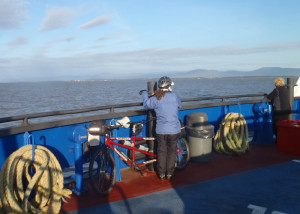
Amazing Isle aux Grues
Very early the next morning, a five minute bike ride brought us to the ferry out to Isle aux Grues (Crane Island). The ferry ride was like a time machine taking us back to an even quieter time in Québec’s pastoral past and one of the most interesting, relaxing and thoroughly delightful places we’ve ever visited. It takes 45 minutes for the ferry to reach Isle aux Grues from Montmagny, but it might as well be a hundred years. The island doesn’t feel like it belongs in our hectic modern world. Less than 150 people live here year round (though many more come in the summer). Kids get to school by plane—a four-minute flight to Montmagny. Until ice forms in the river, the free ferry will take you over for a visit.
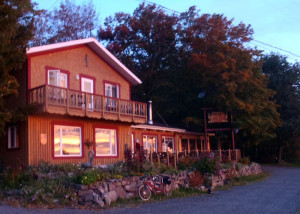
If you love the nightlife and love to boogie, I don’t think you’ll be quite as enamored of Isle aux Grues as we were. It’s pretty quiet there, especially after summer ends. No, make that VERY quiet. We biked every road on the island and didn’t see more than 10 cars. Wild snow geese outnumber humans and motor vehicles by thousands to one. We spent a full day biking, hiking and exploring the island and wished we’d had more time. We absolutely loved it.
For our one night on the island, we stayed at Maisons du Grand Héron, right at the ferry dock. Our room was basic, spotlessly clean, with a very comfortable bed and a spectacular sunrise view out the big windows. That’s one huge advantage of having no nightlife, no television–you go to bed early, get up in time to see the sunrise. Innkeepers Gilles Tardif and Nicole Ferland fed us three marvelous meals including a substantial breakfast right after we got off the ferry, lunch featuring local cheeses and a dinner of black sturgeon caught right from the river and served with vegetables picked minutes before from their own garden.
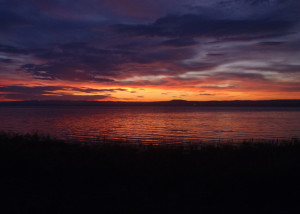
Less than five miles long and a little over a mile wide, Isle aux Grues is the largest of 21 nearby islands, and the only one with a year-round population. In summer, this would be a wonderful place to bring your sea kayak and explore. In September, the quiet roads are perfect for biking. You can’t get lost. About five miles of road are paved, and take you past well kept farms always with vistas to the mountains beyond. If you have a hybrid or fat-tire bike, a gravel road (Chemin de la Batture) leads north and east across a low swampy area that sometimes floods at high tide, toward Isle aux Oies (Goose Island), once a nunnery but now a private hunting club. You can only go so far before you reach a gate, but the ride is worth it.
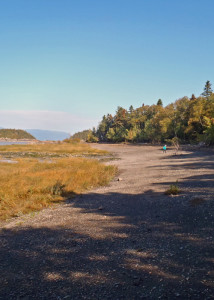
If you don’t bring your own bike, you can rent one right at the ferry dock. A bike is the perfect way to see all the sights on the island, with stops at all the attractions. The tour of the local church is worth an hour for the artwork alone, even if you don’t speak French and get all the details of the tour. And there’s a museum devoted to the history and industry of the islands, and a separate, splendid collection of elaborate costumes from “La Mi-Carême” a local version of Mardi Gras. Incidentally, none of these attractions were “officially” open while we were there but Gilles made a couple of phone calls for us and the doors magically opened. This is a very small island . . . Finally, if you are a fan of great cheese, don’t miss the “Riopelle” and “Mi Carême” cheeses made in the island factory with milk only from the island’s cows.
We also found a lovely hiking trail at the Reserve Naturelle Jean Paul Riopelle (named for a famous painter who lived on the island) at Pointe aux Pins (Pine Point) on the western tip of the island. This trail took us in an easy mile-plus loop including a beach that looked like it had never seen a human before. Spectacular. Incidentally, it was unusually warm for late September when we were there and we were glad we had insect repellent along for the hike. In cooler weather, the mosquitoes wouldn’t be a problem.
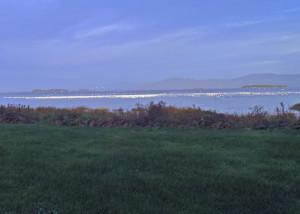
If I had to choose one thing I liked best about Isle aux Grues in the fall, it would be the huge rafts of white snow geese with black wing tips. They rested in shallow water and sometimes rose like smoke and drifted across the sky. I’ve never seen anything quite like it. Amazingly beautiful. This is a favorite stop for migrating waterfowl, and every May, the island hosts a bird-watching conclave. In winter (when you have to travel to the island by plane), they have snowshoeing and “ice canoeing” (racing canoes across ice floes and open water). Marilyn thinks I’m crazy, but I’d love to try it . . .maybe we can time this with our next ski trip to Mont Sainte Anne and Le Massif. As you can tell, one visit to Isle aux Grues was not enough. Superb!
We reluctantly caught a late-morning ferry off Isle aux Grues. Back on the mainland and back in our car, we explored a little more of the shoreline east of Montmagny, then headed back the way we’d come. Our last night was spent in a very nice modern room on the sixth floor of the Four Points Sheraton in Lévis, where we’d originally planned to launch our journey. There, after a soak in the outdoor hot tub, we ate dinner in the hotel restaurant, Cosmos Cafe, enjoying Asian-fusion cuisine in an atmosphere of ever-changing lights with dance-beat music playing in the background. Very modern, very European, very different from L’Isle aux Grues. I felt like I was caught in a time warp, being dragged back into the 21st Century from an older time.
